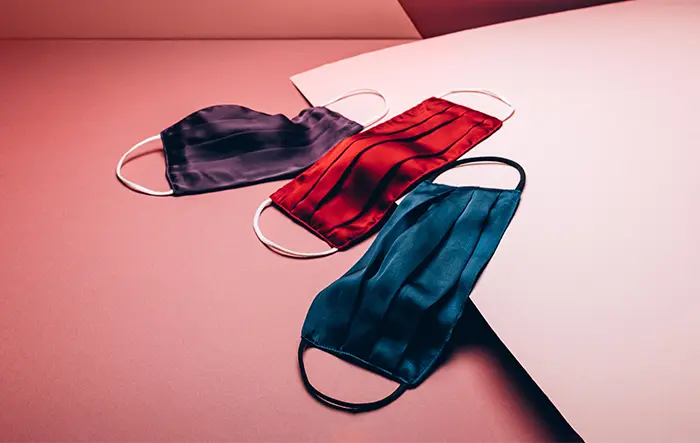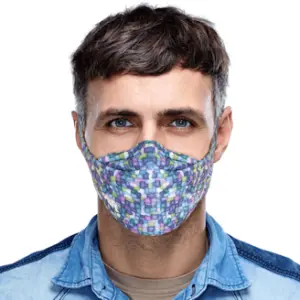For obvious reasons, the world has been going crazy for facemasks. Nearly every material has been used to make a mask by this point, but one seems to stand out from the rest, at least for beauty bloggers: silk. Silk face masks are attributed to clearing up facial acne and being more comfortable to wear than the alternatives. Is it true, though, or is it a fad dreamed up by a few bloggers with silk masks to sell and picked up by others just following the trends?
What Even Is Silk?
You may have memories as a kid of silk coming from silkworms, and its rarity is enough to make it a luxury product. If you’ve handled or worn silk, you know it’s generally a sheer, smooth, breathable fabric.
Silk has very low pliability and give, but is highly breathable and highly moisture-wicking. This makes it very comfortable as the fabric is worn close to the skin, like lingerie, nightgowns, and bedsheets, but it’s also frequently used in everything from suits to parachutes to bicycle tires. It’s a very important fabric, but it’s also relatively renewable and easy to produce in modern times, so it’s great for common applications like masks.
For those of you concerned with ethical arguments, silk is a potentially cruel production. It’s sustainable, it’s biodegradable, it’s natural, and it’s renewable, but it involves allowing moth larva to pupate into cocoons, and then dissolving those cocoons in water, killing the larvae. You can read more about the process here and elsewhere online if you’re curious about how it all works.

Silk production is actually fascinating. It’s one of the most sustainable fabrics in the world; even wool requires fertilizer, feed, and farms. Additionally, since silk has been produced in the same way for millennia, the moths have even evolved with the pressures and can no longer survive on their own.
Silk is a great material for apparel, but does it work well as a mask material?
Silk for Skin Care
Silk has a lot of benefits that help you out with skincare. Let’s go over them.
Silk is antimicrobial. Perhaps one of the biggest benefits of silk is that it’s antimicrobial, antiviral, antibacterial, and all those other antis that help with microscopic nasties. The reason might even be surprising to you.

You may have heard that copper is a natural substance that has antimicrobial properties. Indeed, copper is bio-reactive. Copper disrupts the osmotic balance of cells, including those of bacteria and the construction of viruses. It may also steal electrons from the cells, causing imbalances that make the cells self-destruct. The science is actually still out; no one knows exactly how copper has its antimicrobial properties.
So how does copper play into silk? For that, you have to know how silkworms work. Silkworms live on the mulberry tree, eating the leaves until they reach a stage in their life cycle where they want to pupate and turn into silk moths. When they reach that stage, they start weaving silk into a cocoon about the size of a grape. This is one single long strand of silk, woven in circles or figure-8s around the caterpillar until it is completely encased. The moths, if they develop and emerged, are kind of cute.
The diet of the silkworm determines the composition of the silk. Different breeds of silkworms in different countries produce different kinds of silk. Traditional Chinese silk, made from mulberry, is the best for masks because of this reason. Mulberry, as it is a tree, is high in natural copper content. That means the silkworms are eating diets high in copper, and their resulting silk is infused with copper at a molecular level.
This copper is not enough to do any damage to your body (most copper is not, which is why we use it in everything from pipes to jewelry to IUDs), but it can destroy microbes and viruses that touch it.
This is important in a mask for two reasons.
- It may help prevent the spread of COVID-19. COVID-19 is a virus, and if a virus is denatured by copper in a mask, it’s less likely to be spread to others when you wear the mask.
- It helps prevent skin infections. Acne is, generally, an infection of your pores caused by a variety of factors. Mask-based acne can be caused or exacerbated by a mask trapping grime and bacteria from your breath up against your face, leading to a flare-up.

This all applies primarily to traditional mulberry silk. Luckily, mulberry silk is the easiest and most efficient silk to produce, so it’s by far the most common and least expensive of the silks. Other kinds of silks, like Eri, or Tasar, may or may not have the same copper content. More research needs to be done to discover the truth.
Silk is moisture-wicking and dries quickly. Moisture-wicking means that silk is very good at pulling moisture away from where it contacts the silk and distributing it throughout the fabric. In the case of moisture from your breath, this means the mask takes a lot longer to become saturated, doesn’t stay saturated for long, and evaporates quickly.
If you’ve ever worn a mask for a long period of time at once – particularly a fabric mask made of cotton – you know that it can grow unpleasantly moist very quickly. And yet, you can’t just take it off to let it dry. You need to wear it for your own protection. So, a mask that can stay more comfortable for longer is a good mask to wear.
Another cause of facial acne is excess moisture, especially contaminated moisture like from your breath. You don’t want your skin to completely dry out, of course – that causes acne as well – but if you want moisture on your skin, you need a healthy moisturizer, not just the air from your lungs.

Silk is smooth and comfortable to wear. Another great benefit of silk is that it’s very smooth and very comfortable to wear. Other fabrics, when worn against the sensitive skin of your mask (or even a still-healing acne flare-up) can be very irritating. They can be rough and abrasive, and they can scratch and wear away at the skin. Anyone who has worn a mask and ended up with red spots across their nose and cheeks for days afterward knows exactly what we’re talking about.
Where something like cotton or a rough synthetic fiber (or the plastics from medical masks) might irritate and rub the skin to cause pain and flare-ups, silk is extremely smooth and slippery. It avoids the entire problem by being safe for your skin, even in the most sensitive of conditions.
So, all of that is why silk is great for keeping your skin healthy. Given that rubbing, occlusion, and pressure are all causes of mask-based acne, it’s no wonder that silk can help save your face.
Silk for Skin Comfort
Silk is very comfortable for use as a face mask for several reasons.
First of all, silk has an extremely high thread count. It’s a very dense weave of very light threads, so light that it’s astonishing that it even has the tensile strength it does. It’s not quite spider-like silk levels of strength, but it’s very resilient.

Moreover, silk is very resistant to pilling and runs. A fabric like cotton can pill up because it’s made of thousands of tiny fibers all stuck together. Individual bits of those fibers can come loose, ball up, and otherwise make a nuisance of themselves. Silk is made of singular, extremely long strands; each cocoon from each silkworm is generally only one long strand. Each of these strands is connected to the next, so there are very, very few joints and places where the ends of fibers can come loose.
Now, damage can still happen, so if silk gets torn or otherwise broken, it can cause issues. For the most part, however, silk is very resilient.
Another benefit is the dense weave of silk fabric. It’s resistant to penetration by, for example, facial hair. When you have facial hair, you may find that wearing some kinds of fabrics is uncomfortable because the hair works its way through the fabric in gaps and holes, and then gets caught. This can pull hair when you move or remove the mask, or just cause irritation to the hair follicle. Either way, it’s uncomfortable.
Silk for Mask Filtering
Face masks aren’t just a fashion statement. They’re meant to be a protective device. During the pandemic, wearing a mask is meant to contain the moisture droplets you expel from your breath, which can be contaminated with COVID-19. Even if you don’t feel symptoms, it’s possible that you have the disease.
A lot of misinformation has been spread about the disease, either intentionally or otherwise. Some people don’t wear masks properly. Others wear masks that don’t protect them. If a fabric is too thin, droplets can pass right through it, and it does nothing to protect the people around you. If the fabric is too thick, you end up breathing around the mask instead of through it, eliminating its ability to filter entirely. Some people wear masks with valves in them, which defeats the purpose entirely.
It was initially thought that the only masks that worked were medical-grade N95 masks. These are still the gold-standard for masks, because they have filters designed to work on tiny microbes and moisture, and they have a face seal preventing you from breathing around them. Still, they aren’t readily available.
Fabric, as it turns out, is entirely possible to use as a mask material and has enough protection for everyday use. They might not protect you from catching the disease from someone who isn’t wearing a mask – it can still get in your eyes, or get through the mask, depending on the brand, – but it can help minimize your contribution to spreading it.
Out of all of the fabrics that have been tested throughout the last year, natural fibers turn out to be the best. Cotton and silk are two of the best and for almost opposite reasons.

Silk is excellent because it wicks away moisture. That means it catches the moisture in your breath that would spread disease and pills it away. Microbes are left behind while the moisture evaporates, and it’s not expelled the way it is when breathing. Silk also has copper, as mentioned above, which is capable of killing those leftover microbes, essentially making the mask self-sterilizing within limits. You still have to wash and care for your mask, of course, but it does a little bit of the work itself.
Cotton, meanwhile, operates primarily on electrostatic trapping. Differences in charge between moisture droplets and cotton fibers form a magnetic attraction between them and draw the droplets in. This helps prevent them from escaping when you breathe.
We wrote a rundown of other fabrics as well if you’re curious.
Wrapping Up
If you’re forced to wear a mask – which you should be, until the pandemic is over – you want to minimize the problems you have with it while maximizing the protection it gives the people around you.

Silk is the best material for this protection. It’s relatively easy to breathe through, it traps moisture, it kills microbes, and it’s extremely comfortable. It makes a great inner lining for a multi-fabric mask, and it makes a great mask in multiple layers. You can even work in filters to help, though they may not even be necessary.
It’s worth mentioning that there’s always more research being conducted, and what we’ve written above may not all turn out to be true. More studies may find that silk is even better than we thought, or that initial studies over-estimated its ability to protect people. In part, a lot of it comes down to the construction of the mask. A good mask needs a face seal, but it needs to be breathable enough to not break that seal or hamper breathing. It’s very difficult to manage this kind of mask construction, so many home mask makers don’t bother. As such, you need to strive to get a good mask, not just a silk mask.





















0 Comments